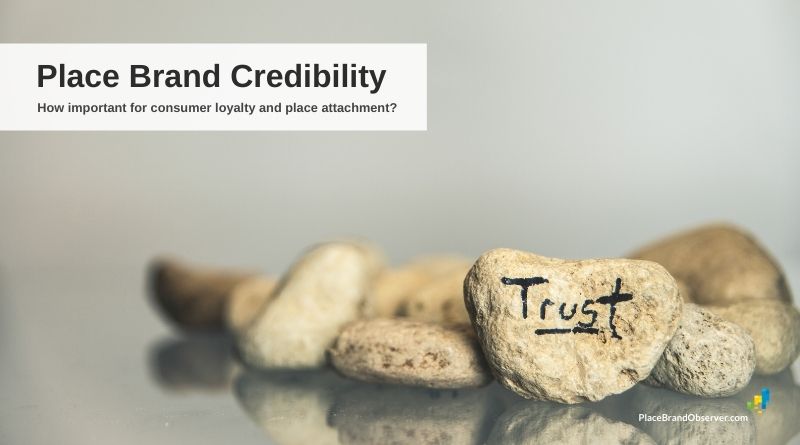The other day I received the email notification of a new issue of the Journal of Brand Management. In it, Bernd Reitsamer (Assistant Professor at the Department of Strategic Management, Marketing and Tourism, University of Innsbruck in Austria), and Alexandra Brunner-Sperdin (University of Applied Sciences Kufstein, Austria) share insights from their research into perceived place brand credibility and its impact on consumer choice – in the context of tourist destinations. Intriguing, not least because place brand perceptions and -credibility were the topic of my doctoral thesis in New Zealand. I caught up with Bernd to find out more about their take on this.
Bernd, you recently published an article on the credibility of place brands. What brought you to investigate this topic?
Brand credibility is nowadays a vital element in building relationships with consumers. It’s crucial that brands provide believable information, keep their promises and deliver on their claims. Today’s consumers are more demanding and experienced than decades before, and they are not ready to make compromises.
At the same time, they are in a constant search for credible and reliable brands that fit with their self-concept and enable them to enter long-lasting relationships. This is particularly the case for place brands, as many destinations are in an ongoing search for building relationships with their guests and turning them into loyal repeat-time visitors. We therefore decided to take a closer look at the emotional, cognitive and behavioral consequences of credible place brands.
Which are the main insights from your research?
We found that place brand credibility is indeed a key antecedent of consumers’ attachment formation and loyalty towards a destination. Credible place brands have the potential to exert a particularly strong direct effect on consumers’ WOM. A positive effect on their intention to return, however, will result only if consumers obtain a feeling of being attached with the place brand beforehand.
What can destination managers do to strengthen consumers’ loyalty?
It is reasonable for destination managers to focus on credible signaling in the first place, as this will positively affect consumers’ attachment and identification with a place. Particularly when consumers are uncertain in their decision-making, informational cues can signal quality, such as, for example, consistency in product quality over time, charging price levels that fit the destination and its offerings, or providing warranties such as free cancellation policies.
The success of such marketing efforts will depend on market characteristics, consumer and competitive behavior, but it is important for managers to show long-term commitment to their signaling approach and assure consumers that their brand promises are kept.
Would you say that innovative marketing messaging is enough these days, to attract visitors and have them return?
Innovative messaging is only one side of the coin. Communication campaigns to reinforce a brand’s ability to reduce risk and generate group identification will remain critical. At the same time it is even more important for DMOs to provide a functioning, high-quality tourism product that is able to keep up with the communicated image.
Today’s tourists are well informed before visiting a destination, exposed to HD/4K photo and video content and a plethora of reviews prior to their journey. It is thus even more important to keep an eye on how to fulfill (and at best surpass) such high expectations.
Which trends do you observe in the Alpine region (Europe), how destinations approach place branding?
In Alpine community-type destinations we can observe a strong commitment towards place branding initiatives, especially when it comes to mergers of smaller DMOs, seasonal collaborations (e.g., providing a joint ski area / brand during winter) or the launch of umbrella brands for larger regions.
Alpine destination products are very much centered on nature, authenticity, tradition, hospitality, culture and sports – and all of these elements play vital roles in brand positioning, are deciding visitation factors for guests and are particularly relevant for a swift comeback from the current Covid-19 pandemic.
The coronavirus pandemic has made many destination marketing and management organizations to rethink how they develop and communicate their brand positioning. What have been the implications for perceived brand credibility?
Soft, authentic and nature-based forms of tourism will be among the first to reach previous demand levels again. Alpine DMOs are thus currently readjusting their campaigns for both national and international markets, emphasizing their high safety levels, natural beauty and warm hospitality – credible signals, that can be fulfilled on site.
In addition, extensive hygiene concepts, free Covid-19 testing and generous cancellations policies should be part of the package.
Which topics linked to place branding, brand credibility and visitor loyalty would you consider important to address in future research?
It is vital to consider the credibility of place brands as important part of the entire customer journey, starting at the pre-consumption stage, but also remaining relevant throughout post-consumption. Post purchase marketing can greatly benefit from credible signals, promises that have been kept on-site and potentially intensify at later stages when reflecting on previous journeys.


